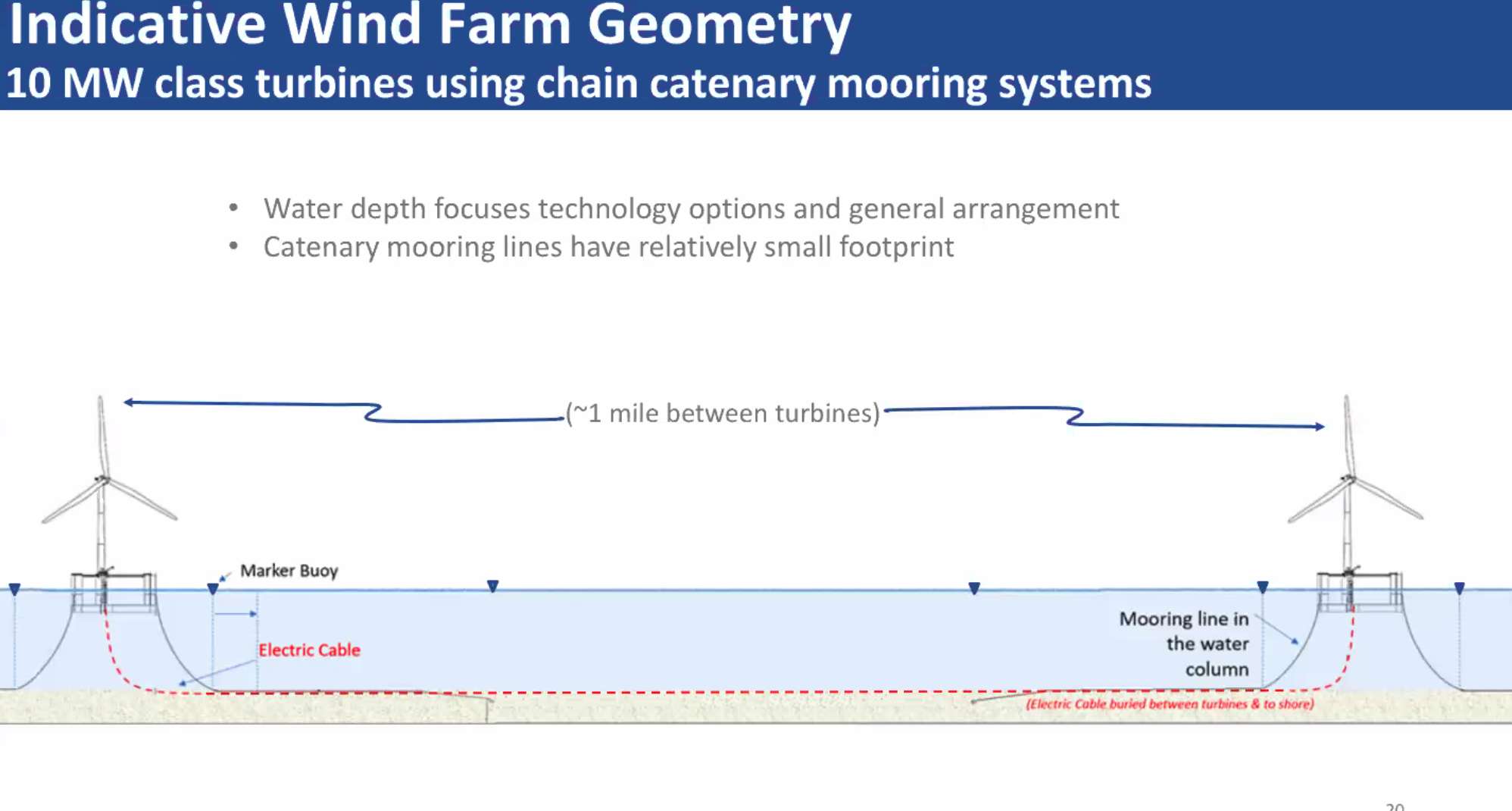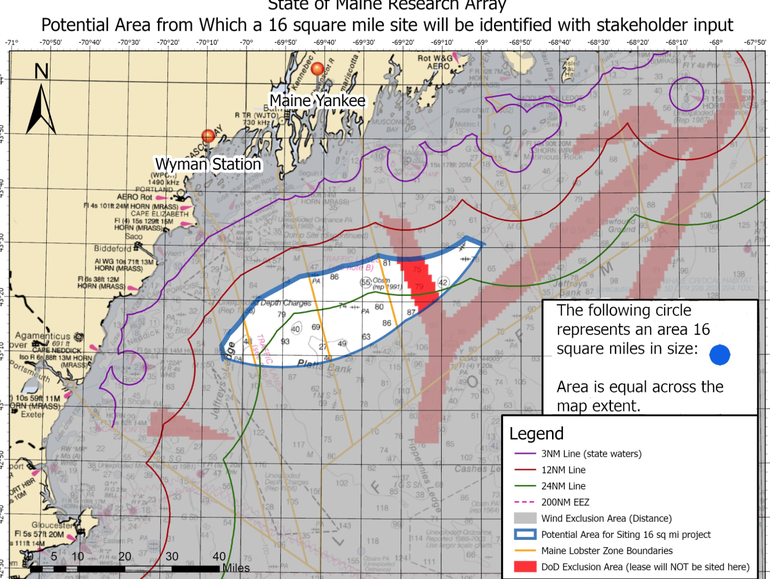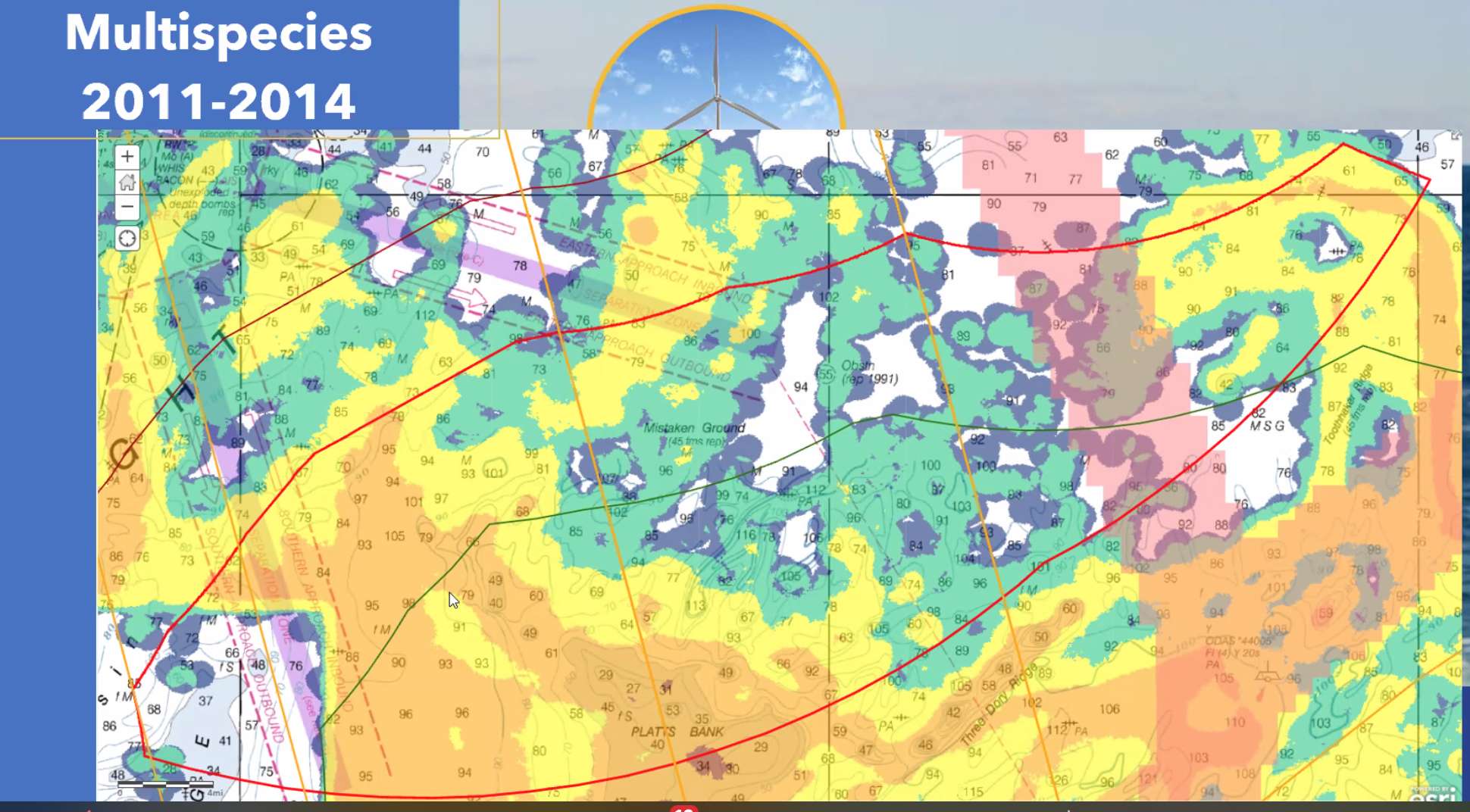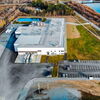
Processing Your Payment
Please do not leave this page until complete. This can take a few moments.
- News
-
Editions
View Digital Editions
Biweekly Issues
- December 15, 2025
- December 1, 2025
- Nov. 17, 2025
- November 03, 2025
- October 20, 2025
- October 6, 2025
- + More
Special Editions
- Lists
- Viewpoints
-
Our Events
Event Info
Award Honorees
- Calendar
- Biz Marketplace
Maine fishermen caught in a quandary over offshore wind-array site
 Courtesy / State of Maine
Seen here is the "area of interest," off the southern Maine coast, for placing a research wind array. The blue dot at right represents the size of the array. Certain swaths, such as the red band that indicates a Department of Defense wind exclusion area, won’t be included for consideration.
Courtesy / State of Maine
Seen here is the "area of interest," off the southern Maine coast, for placing a research wind array. The blue dot at right represents the size of the array. Certain swaths, such as the red band that indicates a Department of Defense wind exclusion area, won’t be included for consideration.
The state of Maine is asking fishermen to help site a proposed offshore wind turbine array that the industry largely opposes.
“We know the industry has emphasized that nowhere is a good place for this. We hear that loud and clear,” Meredith Mendelson, deputy commissioner of the Department of Marine Resources, said at a virtual meeting Wednesday to discuss the array's potential location off the southern Maine coast.
The Governor’s Energy Office is leading the development of a research array of up to 12 turbines covering up to 16 square miles. The exact location and size and number of the turbines haven’t been determined yet.
But the state has identified an oval-shaped "area of interest" for the project, southeast of Casco Bay. To the west, the area crosses onto traditional fishing grounds called Jeffrey’s Basin and Platts Bank. Another fishing area, Mistaken Ground, is in the middle of the oval. The oval covers about 770 square miles. Its landward side starts about 20 miles from shore.
Significant concerns
In November, the state announced its intent to pursue a multi-turbine floating offshore wind research array in federal waters off the coast of Maine. While the project is still in the early planning phases, the state is seeking input from stakeholders on where to put the turbines within the area.
Work sessions were scheduled specifically to gather data and input, and Wednesday’s meeting was the state’s first fisheries work session. The fisheries-focused discussions are aimed to gather input and data from members of the commercial and recreational fishing industry and will focus on fishing activity and fisheries habitat.
Mendelson said concerns heard by the Department of Marine Resources include whether or not fishermen will be able to fish in and around the array, the potential effect on marine species of electromagnetic cables associated with the array, the displacement of fishing jobs, and the role of the array as just the first step for larger commercial arrays in the Gulf of Maine.
“From the DMR’s experience, across the board, I think almost everyone we’ve spoken with has raised significant concerns about offshore wind and has not wanted to see development in the Gulf of Maine,” Mendelson said.
Daniel Salerno, who manages a groundfish sector in New Hampshire, said fishermen are also concerned about the potential for vibrations or resonance traveling through the turbines and into the water, potentially disturbing marine life and their ability to communicate with each other because of underwater noise or pressure.
But GEO Deputy Director Celina Cunningham said it’s the state’s position that, given the interest in offshore wind along the East Coast, the technology will likely come to the Gulf of Maine at a commercial scale at some point in the future. The state considers the smaller-scale research array to be a prudent first step to study the issues through a phased approach, she said.
Fish within the array?
One thing the state wants to test is whether fishermen can fish within the array, noted Mendelson. In its current proposed configuration, the turbines would be placed a mile apart from each other, although that’s open for input, she said.
Semi-submersible platforms, upon which the turbines sit, will be held in place by multiple anchors. The mooring lines for the anchors will likely be chain but possibly synthetic rope. The turbines will be connected to each other by cables that would be buried under the seabed where possible, or otherwise secured to the bottom in some way.

That state has established initial siting criteria but has insufficient data about some activities in the proposed area, including lobster fishing.
One fisherman said it was “hypocritical” that lobstermen were being told to reduce the number of vertical lines associated with their traps, as part of the federal government’s activities to protect the endangered North Atlantic right whale, when the state is planning a system of mooring lines in the water column.
Mendelson noted the state and federal governments would be assessing the potential for entanglement as part of the permitting process.
Conversations with fishermen
Carl Wilson, director of the department’s Bureau of Marine Science, said the area of interest traverses lobster fishing zones D, E and F. State waters are divided into seven lobster zones, from A at the Maine-Canada border to G at the Maine-New Hampshire border.
Several swaths of water that cross through the area of interest are off the table for the 16-square-mile array, he said. That includes two shipping lanes and a U.S. Department of Defense wind exclusion area.
The Department of Marine Resources is in the middle of mapping commercial and recreational fishing activity in the identified area, he said. There’s plenty of data around groundfishing, or "multispecies," activity because groundfish boats are outfitted with vessel monitoring systems that “ping” periodically while underway, making it possible to map their routes.

The southern portion of the identified area, around Jeffrey’s Ledge and Platt’s Bank, for example, is a rich groundfishing area.
Scallop and herring boats also carry tracking systems; Platt’s Bank is important for both, said Wilson.
There’s little data around where lobster fishing takes place. The department has started to fill out that information through individual conversations, Wilson said. The tuna fishery also needs to be mapped, he added.
One thing that’s become apparent through conversations is that “Mistaken Ground,” formerly thought to be featureless mud, is a dynamic area, he said.
The conversations have yielded a universal sentiment.
“We have not had one conversation where people are saying, ‘Yes, put it here,’” Wilson said. “At best, we are getting context into what the fishing activity is and what some of the use patterns are.”
The overall picture from the conversations to date reveal that the array would result in impacts throughout the area of interest, he added.
“We are not going to find an area that’s impact-free,” he said. “We might be able to provide guidance on an area that’s less impacted.”
Generally speaking, he continued, the possibility of minimizing impacts to the fisheries depends on three factors. The number of fishermen drops down with greater distance from shore, in greater depths of water, and on mud bottom.
The department is still in the early stages of conversations with fishermen, he added.
Mainebiz web partners
At the presentations this week, "they" could not answer the question of how an equal investment in solar would compare as to co2 reduction and energy production. Frankly I don't see why this experiment should proceed. NOBODY, except the ultra rich investors, want these wind turbines.
Boys and their toys? Enough is enough.

The Giving Guide
The Giving Guide helps nonprofits have the opportunity to showcase and differentiate their organizations so that businesses better understand how they can contribute to a nonprofit’s mission and work.
Learn More
Work for ME
Work for ME is a workforce development tool to help Maine’s employers target Maine’s emerging workforce. Work for ME highlights each industry, its impact on Maine’s economy, the jobs available to entry-level workers, the training and education needed to get a career started.
Learn More
Groundbreaking Maine
Whether you’re a developer, financer, architect, or industry enthusiast, Groundbreaking Maine is crafted to be your go-to source for valuable insights in Maine’s real estate and construction community.
Learn more-
The Giving Guide
The Giving Guide helps nonprofits have the opportunity to showcase and differentiate their organizations so that businesses better understand how they can contribute to a nonprofit’s mission and work.
-
Work for ME
Work for ME is a workforce development tool to help Maine’s employers target Maine’s emerging workforce. Work for ME highlights each industry, its impact on Maine’s economy, the jobs available to entry-level workers, the training and education needed to get a career started.
-
Groundbreaking Maine
Whether you’re a developer, financer, architect, or industry enthusiast, Groundbreaking Maine is crafted to be your go-to source for valuable insights in Maine’s real estate and construction community.
ABOUT
NEW ENGLAND BUSINESS MEDIA SITES
No articles left
Get access now
In order to use this feature, we need some information from you. You can also login or register for a free account.
By clicking submit you are agreeing to our cookie usage and Privacy Policy
Already have an account? Login
Already have an account? Login
Want to create an account? Register
Get access now
In order to use this feature, we need some information from you. You can also login or register for a free account.
By clicking submit you are agreeing to our cookie usage and Privacy Policy
Already have an account? Login
Already have an account? Login
Want to create an account? Register







4 Comments